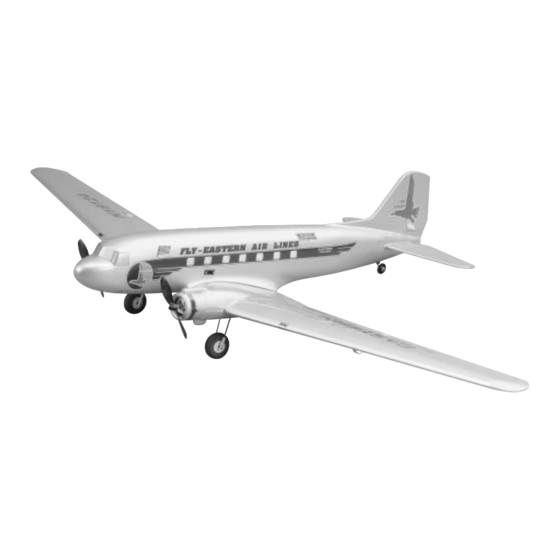GREAT PLANES Douglas DC-3 Gebrauchsanweisung - Seite 18
Blättern Sie online oder laden Sie pdf Gebrauchsanweisung für Spielzeug GREAT PLANES Douglas DC-3 herunter. GREAT PLANES Douglas DC-3 20 Seiten.

Ground Check
Before you fly you should perform one last overall inspection
to make sure the model is truly ready to fly and that you
haven't overlooked anything. If you are not thoroughly familiar
with the operation of R/C models, ask an experienced
modeler to perform the inspection. Check to see that you
have the radio installed correctly and that all the controls are
connected properly. The motors must also be checked by
confirming that the props are rotating in the correct direction
and the motors sound like they are reaching full power. Make
certain all control surfaces (elevators, rudder, ailerons) are
secure, the pushrods are connected, the controls respond in
the correct direction, radio components are securely
mounted and the C.G. is correct.
Range Check
Ground check the operational range of your radio before the
first flight of the day. With the transmitter antenna collapsed
and the receiver and transmitter on, you should be able to
walk at least 100 feet away from the model and still have
control. Have an assistant stand by your model and, while
you work the controls, tell you what the control surfaces are
doing. Repeat this test with the motors running at various
speeds with an assistant holding the model, using hand
signals to show you what is happening. If the control
surfaces do not respond correctly, do not fly! Find and
correct the problem first. Look for loose servo connections or
broken wires, corroded wires on old servo connectors, poor
solder joints in your battery pack or a defective cell, or a
damaged receiver crystal from a previous crash.
MOTOR SAFETY PRECAUTIONS
Failure to follow these safety precautions may result
in severe injury to yourself and others.
• Get help from an experienced pilot when learning to
operate motors.
• Use safety glasses when starting or running motors.
• Do not run the motors in an area of loose gravel or sand;
the propellers may throw such material in your face or eyes.
• Keep your face and body as well as all spectators away
from the plane of rotation of the propellers as you start and
run the motors.
• Keep these items away from the props: loose clothing,
shirt sleeves, ties, scarfs, long hair or loose objects such as
pencils or screwdrivers that may fall out of shirt or jacket
pockets into the props.
• The motors get hot! Do not touch them during or right
after operation.
• The electric motors and battery used in your DC-3 EP
ARF are very powerful and the spinning propellers have a lot
of momentum; therefore, if you touch a propeller while it is
spinning it may inflict severe injury. Respect the motors and
propellers for the damage they are capable of and take
whatever precautions are necessary to avoid injury. Always
disconnect and remove the battery until you are ready to fly
again and always make sure the switches are turned off
before connecting the battery.
AMA SAFETY CODE (
Read and abide by the following Academy of Model
Aeronautics Official Safety Code:
1. I will not fly my model aircraft in sanctioned events, air
shows, or model flying demonstrations until it has been
proven to be airworthy by having been previously successfully
flight tested.
2. I will not fly my model aircraft higher than approximately
400 feet within 3 miles of an airport without notifying the
airport operator. I will give right of way to and avoid flying in
the proximity of full scale aircraft. Where necessary an
observer shall be used to supervise flying to avoid having
models fly in the proximity of full scale aircraft.
3. Where established, I will abide by the safety rules for the
flying site I use and I will not willfully and deliberately fly my
models in a careless, reckless and/or dangerous manner.
7. I will not fly my model unless it is identified with my name
and address or AMA number, on or in the model.
9. I will not operate models with pyrotechnics (any device
that explodes, burns, or propels a projectile of any kind).
Radio Control
1. I will have completed a successful radio equipment ground
check before the first flight of a new or repaired model.
2. I will not fly my model aircraft in the presence of
spectators until I become a qualified flier, unless assisted by
an experienced helper.
3. I will perform my initial turn after takeoff away from the pit
or spectator areas and I will not thereafter fly over pit or
spectator areas, unless beyond my control.
4. I will operate my model using only radio control frequencies
currently allowed by the Federal Communications Commission.
18
EXCERPT
General
)
